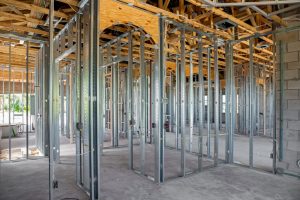 Framing is a critical part of the building process, but the materials we use to frame can often influence the final product and repairs down the road. When framing a residential home, there are two main choices: steel and wood. Wood is still the most common choice for residential buildings, but steel has become a viable alternative under the right conditions and locations.
Framing is a critical part of the building process, but the materials we use to frame can often influence the final product and repairs down the road. When framing a residential home, there are two main choices: steel and wood. Wood is still the most common choice for residential buildings, but steel has become a viable alternative under the right conditions and locations.
Steel Framing Benefits
Unlike wood, steel is guaranteed to be straight and durable. A common problem with wood framing is warped wood or cracked boards, which can drive up costs and slow down the process. However, steel studs don’t suffer from any of these problems and come in the same sizes as traditional wood studs.
Steel studs also include knockouts for electrical cables and a variety of flanges for mounting. This makes them easy to install, as contractors have a predictable pattern to follow. Additionally, steel will not rot, warp, or bow after installation. They can remain in the walls indefinitely without damage.
This makes them incredibly durable and reduces the impact of issues like water leaks, mold, fires, or termites. Overall, steel studs offer some incredible benefits over the common wood, but they aren’t without drawbacks
Steel Framing Cons
Unlike wood, steel is not easy to shape or cut. While wood can be somewhat malleable, steel is rigid. This is both a benefit and a drawback, but for a first-timer or a repair, this could prove a difficult problem. Steel is much harder to cut and requires significantly more tools to cut safely.
This also extends to other areas of the process, such as electrical boxes or trim molding. While these can be attached to steel, many will find it much easier to work with wood around areas like door frames and windows. This also extends to drywall installation, as drywall screws are not as easy to drive into metal as wood. This is the obvious tradeoff for durability and weight.
While steel studs are excellent for difficult areas like bathrooms, basements, and water-prone areas, they do have issues with heat transfer. Since steel will transfer heat much better than wood, there can be issues with heat loss. This is solved by allowing a larger thermal gap, but it is an issue nonetheless.
Finally, it can be difficult to find steel studs locally. While it is available, the quantity contractors might need, could prove to be a roadblock. Local hardware stores rarely carry enough to frame a house, so it might require a special order.
Why Choose Steel Studs?
As with any building material, there are many things to consider when choosing between the different kinds of material. What works well for one area might not work well for another. That being said, we’ve done our best to present the pros and cons of steel studs.
They’re fantastic for areas prone to water damage and they work very well as a replacement for wood studs due to their durability, but they lack the flexibility and ease of use offered by wood. Ultimately, the choice between steel and wood comes down to need. What does the project require? Can it be solved by wood or steel? Does this area need to be resistant to water or does it need to be thermally insulated?
By asking these questions you can determine if steel studs are right for you. For those still unsure, it’s best to contact a professional. Give us a call and learn more today.
